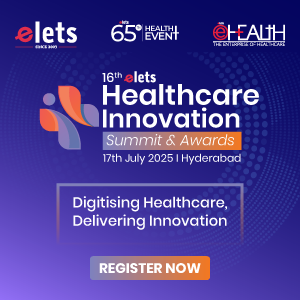The Indian healthcare industry currently estimated at around US$ 34 billion is growing dynamically. In this growth, the private sector is taking the lead with more than 70% share of the market. The industry is currently going through a transition phase where on the one side there is a dearth in the number of facilities to serve the population adequately and on the other side, there is higher demand for quality care services. This has become a challenge for healthcare providers in the country. The healthcare system today is complex, with various stakeholders involved such as hospitals, insurance companies, diagnostic facilities etc. In addition, it is critical at this stage to standardise the processes of these industry stakeholders.
The healthcare system generates enormous amounts of information everyday, and managing it is a big challenge for all the healthcare entities. Over time, healthcare entities have understood the value of technology-based systems to support their processes, functions, streamline operations and manage information generated. For this, all entities have made significant investments in IT in order to improve efficiency and productivity.

Being part of the common system, all the entities interact with each other and share information at various stages, but this critical coordination process was not part of the IT applications being used by each. Their applications were designed such that they were not able to exchange information online on a common platform. The applications did not account the future need of data integration for the benefit of the consumer.

Today, the consumer deals with different departments of various entities and some form of information related to the consumer is generated, but this largely remains in the individual facility’s system unless a request for sharing it is received. Moreover, when the system has to share information with another entity it is mostly in a paper format.

These limitations need to be dealt with to enable doctors, patients and others to leverage the benefits of integrated information Systems. On a daily basis, healthcare organizations face a challenge of keeping medical records without compromising their privacy and security and maintaining them for the stipulated time (as required by law).

The Concept
Today there are solutions in the market to deal with the complexities of managing huge amounts of information that is produced by a healthcare delivery system on a regular basis. The increasingly felt need to access all related medical information for the purpose of research, improve clinical outcomes and gain knowledge – is driving many IT majors to develop Integrated Healthcare applications.
The concept of a ‘Connected Healthcare System’ can be defined as an environment involving all the healthcare entities � the providers, payers, law makers and regulators and the professionals – interacting with each other using IT systems designed on standards-based common platform to allow easy access, sharing and exchange of information at all levels.
For this environment to take shape, various health IT applications involved in the system need to provide robust and flexible base for all information based interactions and transactions keeping in mind the key players in the system namely, patients, doctors, decision makers, and other healthcare professionals.

Apart from flexibility, the other key areas of concern would be data security, privacy, interoperability, authorization levels, workflow capacities and above all data integrity.
This concept of connected healthcare has its own stages of evolution, which can be described as follows:
Stages of Evolution for Connected Healthcare
Stage 1 – Fragmented traditional systems existed, which maintained paper records, without using any kind of IT solutions.
Stage 2 – Automation of individual systems happened, generating some form of electronic records.
Stage 3 – Applications within the organization were integrated, bringing all records into single package
Stage 4 – Current scenario � Some form of information exchange and system integration amongst entities like hospitals, insurance providers, Third party administrators etc. has started.
Stage 5 – Completely integrated systems will exist, sharing and exchanging information across standards-based applications on a common platform improving efficiency and accessibility – “Connected Healthcare”
Feasibility
The big question for the Indian healthcare system is related to its preparedness for this kind of collaboration to share information amongst all healthcare entities. Currently, majority of the healthcare entities are still struggling to put their IT solutions in place and streamline operations.
Thus, it will be a long way to reach ‘Stage 5’ of the evolution for Connected Healthcare systems. Moreover, each of the stakeholders of the system will have numerous challenges to face before finalising the blueprint.
Though, Microsoft has designed a “Connected Healthcare Framework Architecture and Blueprint” for the organisations to follow, there cannot be any progress towards the Connected Healthcare System unless the there are standards in place for healthcare providers and payers of the Indian healthcare ecosystem.Nevertheless, some of the key drivers for the growth of this connected healthcare system would be:
Drivers
-
Standardiszation – set of standards for – healthcare providers, payers and other entities – for their processes and functions, in place would definitely serve as a key driver for moving towards an integrated system.
-
Service oriented approach – adoption of service-oriented architecture for development of healthcare applications would bring down the challenges of interoperability and application integration.
-
Reliability and Transparency – all the stakeholders in the system must adhere to best practices and maintain trustworthiness to make the entire system work efficiently and transparently.
Key Challenges
Some of the key challenges to put connected healthcare model in place are:
-
Low IT budgets – hospitals have a very low budget for IT investments and do not spend more than 2 percent of their revenues on IT solutions.
-
Attitude towards IT adoption – implementing IT applications is still not accepted as a good change for the system.
-
Higher investments – High investments will be required to replace legacy systems with the new applications compliant for an integrated systems model.
-
Data transformation from legacy systems – transforming data from legacy systems into new ones is a mammoth task and it would be critical to maintain data integrity.
-
Data security and privacy – medical information related to patients is highly confidential so maintaining its privacy and security is a critical factor.
-
Interoperability and interconnectivity between diverse systems – All healthcare entities are currently using diverse systems and it is not feasible to provide interconnectivity between them.
-
Patient Identification across systems – How will patients be identified across systems? If the solution has to be some sort of a universal identifier number then designing, it would again be a major challenge for the entities in the entire healthcare system.
-
Acceptability and adoptability amongst various entities – The law makers and regulators have to make sure that the idea of implementing new systems for providing integrated services is accepted by all the healthcare entities and later adopted by all.
Key Benefits
-
Data accessibility – anytime, anywhere availability of patient information – patient information could be accessed by doctors, patients, and others anytime through the use of handheld devices, wireless technologies and even remote access.
-
Improved efficiency and streamlined processes – as the systems will have a standards-based platform for maintaining and sharing information it will reduce time: as in waiting time, reporting time, administrative functions etc., making processes more efficient.
-
Improved decision making – with patient information available across the system doctors would have an edge in making clinical decisions thus improving quality of care.
-
Advantages for research and development – integrated information would be advantageous for researchers in hospitals, pharmaceuticals, insurance companies etc. for designing new products and taking decisions for better clinical outcomes.
-
Reduced costs – integrated information will help all entities in reducing costs by avoiding data redundancy, better medical records management, saving over administrative and infrastructure costs for physical record maintenance, reducing medical errors and thus saving on duplicate tests and admissions etc.
-
Increase in Medical tourism – quality services and efficient processes would help hospitals serve more foreign patients at low costs thus promoting medical tourism.

Be a part of Elets Collaborative Initiatives. Join Us for Upcoming Events and explore business opportunities. Like us on Facebook , connect with us on LinkedIn and follow us on Twitter , Instagram.
"Exciting news! Elets technomedia is now on WhatsApp Channels Subscribe today by clicking the link and stay updated with the latest insights!" Click here!







